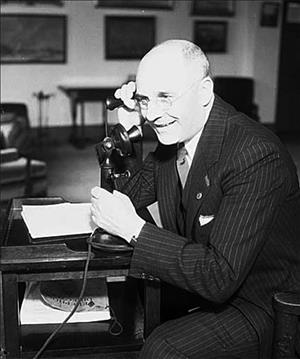William O. McKay was a Seattle automobile dealer and civic leader, involved in Community Fund drives, the Seattle Chamber of Commerce, and automobile-business organizations. He was involved in Seattle's first Seafair celebrations and in 1951 was crowned Neptune Rex II, the second Seafair king. In recognition of William McKay's two decades of commitment to the region's business community and his dedication to civic activities, the Seattle-King County Association of Realtors named William McKay First Citizen of 1942.
Early Years
William O. McKay was born in California in 1887 and arrived in Seattle with his family as a pre-adolescent in 1898. His father was a successful businessman in the lumber industry in both California and Washington. William, as it turned out, emulated his father's success.
A restless student, McKay left the University of Washington in his junior year to begin a life-long career in the automobile business. He worked first as a sales representative, and later as owner of his own company.
World War I interrupted his business career. During the war he received a commission as a Marine Corps infantry officer. He fought with the 91st Division in France at St. Mihiel, Meuse-Argonne, and Ypres-Lyon.
Selling Cars
Within a year of his return to civilian life in 1919, McKay began selling Ford automobiles as northwest manager of the William L. Hughson Company. Two years later, in November 1922 the young entrepreneur formed the William O. McKay Company.
His immediate success with the new enterprise enabled him to move from leased operations on Capitol Hill's Pike/Pine Street automotive-sales corridor to his own building, a two-story utilitarian structure located on Westlake Avenue, at Mercer Street. Built in 1922, his South Lake Union showroom sat in the shadow of the Ford Assembly Plant (in 2006, Shurgard Self-Storage), where cars were assembled for local sale.
Three years later, in 1925, McKay built a more ornate, one-story terra cotta showroom adjacent to the original building. The new showroom gave him additional room to display the line of luxury Lincolns he had added to his inventory. Designed by local architects Harlan Thomas and Clyde Grainger, designers of Seattle's Sorrento Hotel, it was more befitting to showcase a car built for the affluent than was the less ornate building next door housing the more modestly priced Ford inventory.
The showroom, accessed through an elaborately carved wooden entryway, resembled a Mediterranean courtyard and featured a vaulted ceiling with an enormous chandelier and Ionic columns. In 2003, the Washington Trust for Historic Preservation placed both buildings on its list of the state's most endangered properties. On April 19, 2006, the Seattle Landmarks Preservation Board designated both South Lake Union showrooms as city landmarks.
For the Community
Settled in his new location, McKay soon became involved in civic affairs and in Seattle boosterism. This involvement lasted for the rest of his life. Twice he headed Community Fund drives. He also assumed leadership roles in the Seattle Chamber of Commerce and in various automotive-business organizations.
With World War II and the conversion from peacetime manufacture of automobiles to wartime armaments, new car showrooms across the nation fell empty. Now 54 and still in the Marine Corps Reserves, but too old to fight, McKay became the first director of the civilian protection division of the Civilian War Commission, established in the wake of the attack on Pearl Harbor to protect Seattle's citizenry against another attack.
War Years
Within months he had returned to active duty as a Lieutenant Colonel and served as recruiting officer in charge of the Seattle Recruiting District. In 1942, The Seattle Board of Realtors honored him with its First Citizen Award. He received his bronze plaque while on active duty as a Lt. Colonel in the U.S. Marine Corps Reserves.
It was while serving at this post, in 1943, that he learned that his only son, Theodore, also a marine, was killed in action in the Pacific Theater.
Last Years and Legacy
With peacetime came a new affluence in the nation. McKay's automobile business began to thrive again. He also continued his role as civic leader, and ever the Seattle booster, sat on the board of the newly formed Greater Seattle, Inc. In 1951 McKay was crowned Neptune Rex II, the second Seafair king.
In 1956, McKay and his wife Leah traveled to Melbourne to attend the Olympic Games. During the return trip, while cruising among the Fiji Islands, he was stricken and died a few days later, on December 17, 1956. He is buried at Latoka, Fiji Islands.
During his lifetime in Seattle, McKay was at the forefront of two important movements in the region. He envisioned the rapid growth of the automobile industry in the Pacific Northwest and helped guide it with his expert salesmanship and leadership abilities. But he was also an energizer for civic and philanthropic activities in the Puget Sound region and a visionary for Seattle Seafair. Although he is no longer in the memory of most Seattleites, this annual month-long event is one of his legacies. It has been celebrated each August for more than a half-century.

